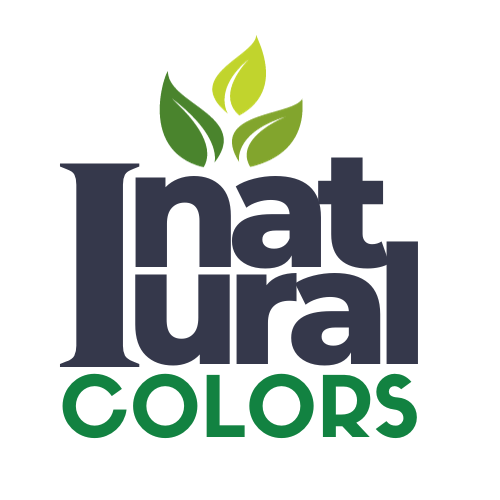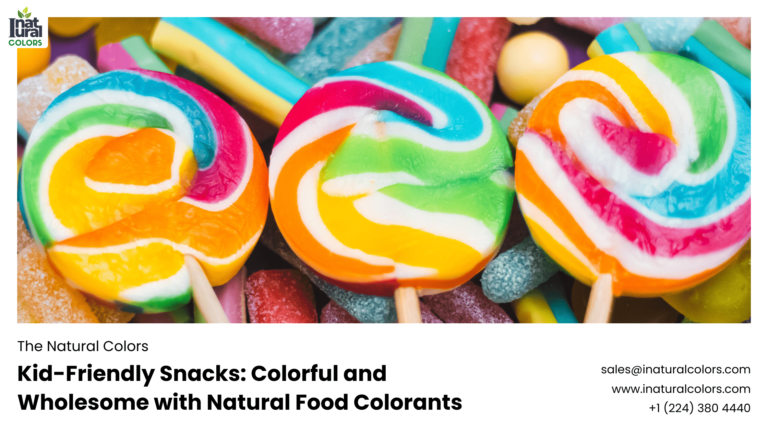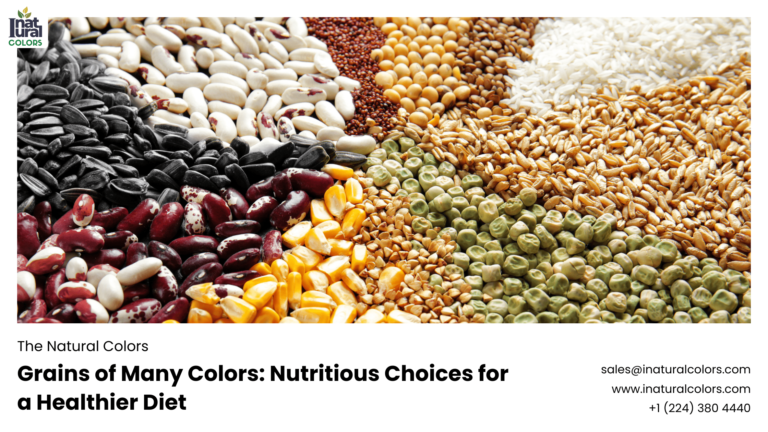Beautiful Plants For Your Interior

Trends in the Natural Colors Industry
Introduction
The natural colors industry has seen significant growth and transformation over the past decade. Driven by increasing consumer demand for healthier and more sustainable products, businesses across various sectors are adopting natural colorants to replace synthetic dyes. This shift is not only influenced by health concerns but also by environmental and ethical considerations. In this article, we will explore the current trends in the natural colors industry, examining the factors driving growth, emerging technologies, and future prospects.
Growth Drivers in the Natural Colors Industry
Health and Wellness Trends
One of the primary drivers of growth in the natural colors industry is the global trend towards health and wellness. Consumers are becoming more aware of the potential health risks associated with synthetic dyes, such as allergic reactions and hyperactivity in children. As a result, there is a growing preference for products that use natural colorants derived from plants, fruits, vegetables, and minerals.
According to a report by Grand View Research, the global natural food colors market size was valued at USD 1.6 billion in 2019 and is expected to expand at a compound annual growth rate (CAGR) of 8.4% from 2020 to 2027 . This growth is indicative of the increasing consumer demand for natural ingredients in food and beverages.
Environmental and Ethical Considerations
Environmental sustainability and ethical sourcing are becoming crucial factors for consumers when choosing products. Natural colors are derived from renewable sources, making them more environmentally friendly compared to synthetic dyes, which often rely on petrochemical processes. Furthermore, ethical sourcing practices, such as fair trade and organic farming, resonate with consumers who are concerned about the impact of their purchases on the environment and communities.
The use of natural colors can also reduce the carbon footprint of production processes. For instance, natural colorants typically require less energy to produce and result in fewer hazardous by-products compared to synthetic alternatives.
Regulatory Pressure
Regulatory bodies around the world are imposing stricter regulations on the use of synthetic dyes in food, cosmetics, and pharmaceuticals. For example, the European Union has stringent regulations on the use of certain synthetic dyes, and the U.S. Food and Drug Administration (FDA) continuously monitors and regulates color additives. This regulatory pressure is prompting manufacturers to seek safer and compliant alternatives, thus boosting the demand for natural colors.
Technological Advancements
Advancements in extraction and processing technologies have made it easier to produce natural colors with greater stability, consistency, and color intensity. Techniques such as supercritical fluid extraction, ultrasound-assisted extraction, and fermentation are enhancing the efficiency and scalability of natural color production.
Innovations in formulation and delivery systems, such as encapsulation, have also improved the stability and shelf-life of natural colors, making them more appealing to manufacturers. These technological advancements are lowering the barriers to entry and expanding the range of applications for natural colorants.
Emerging Trends in the Natural Colors Industry
Plant-Based and Vegan Products
The rise of plant-based and vegan diets has created new opportunities for the natural colors industry. Plant-based foods, beverages, and cosmetics are increasingly popular among consumers seeking cruelty-free and environmentally sustainable products. Natural colors derived from plant sources are a perfect fit for these products, aligning with the ethical and health values of plant-based consumers.
For instance, beetroot, spirulina, turmeric, and annatto are commonly used natural colorants in plant-based foods. These ingredients not only provide vibrant colors but also offer additional health benefits, such as antioxidants and anti-inflammatory properties.
Clean Label Movement
The clean label movement emphasizes transparency and simplicity in product ingredients. Consumers are demanding products with recognizable and minimally processed ingredients, and natural colors fit seamlessly into this trend. Clean label products often feature natural colors on their ingredient lists, appealing to health-conscious consumers who prefer to avoid artificial additives.
Manufacturers are responding to this demand by reformulating their products to eliminate synthetic dyes and replace them with natural alternatives. This shift is particularly evident in the food and beverage industry, where clean label products are gaining market share.
Functional Foods and Nutraceuticals
Functional foods and nutraceuticals are foods and beverages that provide health benefits beyond basic nutrition. These products often incorporate natural ingredients with functional properties, such as antioxidants, vitamins, and minerals. Natural colors, which are often rich in bioactive compounds, are increasingly used in functional foods to enhance both the visual appeal and the health benefits.
For example, anthocyanins, which are natural pigments found in berries, are known for their antioxidant properties. Incorporating these pigments into functional foods can enhance their health benefits and appeal to health-conscious consumers.
Personal Care and Cosmetics
The personal care and cosmetics industry is another major consumer of natural colors. As consumers become more aware of the potential health risks associated with synthetic ingredients in cosmetics, there is a growing demand for products formulated with natural and safe ingredients. Natural colorants, such as beetroot powder, cocoa powder, and plant extracts, are being used in a wide range of cosmetic products, including lipsticks, eyeshadows, and foundations.
The global natural cosmetics market is expected to grow significantly in the coming years. According to a report by Market Research Future, the natural cosmetics market is projected to reach USD 25.11 billion by 2025, growing at a CAGR of 9.76% from 2019 to 2025 . This growth is indicative of the increasing consumer preference for natural and organic beauty products.
Regional Trends
The adoption of natural colors varies across different regions, influenced by cultural preferences, regulatory environments, and market maturity. In North America and Europe, where consumers are highly aware of health and sustainability issues, the demand for natural colors is particularly strong. These regions also have stringent regulations on food additives, further driving the shift towards natural colorants.
In contrast, the Asia-Pacific region is witnessing rapid growth in the natural colors market due to the expanding middle class, increasing disposable incomes, and rising awareness of health and wellness. Countries such as India, China, and Japan are experiencing significant growth in the food and beverage, cosmetics, and pharmaceutical industries, creating new opportunities for natural color manufacturers.
Challenges in the Natural Colors Industry
Cost and Availability
One of the main challenges in the natural colors industry is the higher cost of natural colorants compared to synthetic dyes. Natural colors are often more expensive due to the complexities involved in cultivation, extraction, and processing. Additionally, the availability of raw materials can be influenced by seasonal variations and agricultural conditions, leading to supply chain uncertainties.
Manufacturers need to balance the cost and availability of natural colors with the demand for high-quality, sustainable products. This challenge can be mitigated through investments in agricultural practices, sustainable sourcing, and technological innovations to improve extraction efficiencies.
Stability and Performance
Natural colors can be less stable than synthetic dyes, particularly when exposed to light, heat, and pH variations. This can affect the consistency and shelf-life of products, posing challenges for manufacturers. However, ongoing research and development are addressing these issues through advanced formulation techniques and the use of stabilizing agents.
Encapsulation, for example, is a technique that can protect natural colorants from environmental factors, enhancing their stability and performance in various applications. By improving the stability of natural colors, manufacturers can expand their use in a wider range of products.
Regulatory Compliance
While regulatory pressures are driving the adoption of natural colors, navigating the complex regulatory landscape can be challenging for manufacturers. Different regions have varying regulations and standards for color additives, requiring manufacturers to ensure compliance with local laws. This can involve significant investment in research, testing, and documentation to meet regulatory requirements.
Collaboration with regulatory bodies, industry associations, and research institutions can help manufacturers stay informed about regulatory changes and ensure compliance. By proactively addressing regulatory challenges, manufacturers can build trust with consumers and maintain market access.
Future Prospects of the Natural Colors Industry
Innovation and Research
The future of the natural colors industry will be shaped by continued innovation and research. Advances in biotechnology, such as the use of genetically modified organisms (GMOs) and microbial fermentation, have the potential to revolutionize the production of natural colors. These technologies can enhance the yield, consistency, and functionality of natural colorants, making them more competitive with synthetic dyes.
For example, researchers are exploring the use of algae and fungi as sources of natural pigments. These organisms can be cultivated under controlled conditions, reducing the reliance on traditional agricultural sources and improving sustainability. Innovations in genetic engineering are also enabling the development of novel colorants with enhanced properties, such as improved stability and color intensity.
Sustainable Sourcing
Sustainability will continue to be a key focus in the natural colors industry. Consumers are increasingly demanding transparency and ethical practices in the supply chain, prompting manufacturers to adopt sustainable sourcing practices. This includes sourcing raw materials from organic farms, supporting fair trade initiatives, and investing in sustainable agriculture.
Companies are also exploring circular economy models, such as using food waste and by-products as sources of natural colorants. For example, the peels and seeds of fruits and vegetables can be repurposed to extract valuable pigments, reducing waste and promoting sustainability.
Market Expansion
The natural colors market is expected to expand across various industries, including food and beverages, cosmetics, pharmaceuticals, and textiles. The growing popularity of clean label products, plant-based diets, and functional foods will drive demand for natural colorants in the food and beverage sector. In the cosmetics industry, the trend towards natural and organic beauty products will continue to fuel the adoption of natural colors.
Emerging markets in Asia, Latin America, and Africa offer significant growth opportunities for natural color manufacturers. These regions are experiencing rapid economic growth, urbanization, and changing consumer preferences, creating new markets for natural and sustainable products.
Collaboration and Partnerships
Collaboration and partnerships will play a crucial role in the future of the natural colors industry. Manufacturers, researchers, and industry associations can work together to address challenges, share knowledge, and drive innovation. Collaborative efforts can also help standardize quality and safety standards for natural colorants, enhancing consumer confidence and market acceptance.
Public-private partnerships and government support can also facilitate research and development in the natural colors industry. Funding and incentives for sustainable practices, research initiatives, and technological advancements can accelerate the growth and adoption of natural colorants.
Conclusion
The natural colors industry is experiencing a period of dynamic growth and transformation. Driven by health and wellness trends, environmental sustainability, regulatory pressures, and technological advancements, the demand for natural colorants is on the rise. Emerging trends, such as the clean label movement, plant-based products, and functional foods, are creating new opportunities for natural colors across various sectors.
Despite challenges related to cost, stability, and regulatory compliance, the future of the natural colors industry looks promising. Continued innovation, sustainable sourcing, market expansion, and collaboration will shape the industry’s trajectory, making natural colors an integral part of the global market.
As consumers increasingly seek healthier and more sustainable products, the natural colors industry is poised for continued growth and success. By staying at the forefront of trends and leveraging technological advancements, companies like iNatural Colors can lead the way in providing high-quality, safe, and environmentally friendly color solutions.



